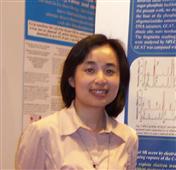1. Yu Shao, Yanfang Dong, Darel Hunting, Yi Zheng,* Léon Sanche, Unified mechanism for the generation of isolated and clustered DNA damages by a single low energy (5-10 eV) electron, J. Phys. Chem. C 121, 2466-2472 (2017).
2. Wenzhuang Chen, Shiliang Chen, Yanfang Dong, Pierre Cloutier, Yi Zheng,* Léon Sanche, Absolute Cross Sections of DNA strand break and crosslink induced by Low Energy Electron, Phys. Chem. Chem. Phys. 18, 32762-32771 (2016).
3. Jiawen Liu, Xiaobin Yao, Pierre Cloutier, Yi Zheng,* Leon Sanche, DNA strand breaks induced by 0-1.5 eV photoelectrons under atmospheric pressure, J. Phys. Chem. C 120, 487-495 (2016).
4. Xiaobin Yao, Chuanna Huang, Xiaoping Chen, Yi Zheng,* Leon Sanche, Chemical radiosensitivity of DNA induced by gold nanoparticles, J. Biomed. Nanotechnol. 11(3), 478-485 (2015).
5. Qianhong Bao, Yunfeng Chen, Yi Zheng,* Léon Sanche, Cisplatin radiosensitization of DNA irradiated with 2-20 eV electrons: role of transient anions, J. Phys. Chem. C 118, 15516 (2014).
6. Xinglan Luo, Yi Zheng,* Léon Sanche, DNA strand breaks and crosslinks induced by transient anions in the electron-energy range 2-20 eV, J. Chem. Phys. 140, 155101 (2014).
7.Fangxing Xiao, Xinglan Luo, Xianzhi Fu, Yi Zheng*, Cleavage enhancement of specific chemical bonds in DNA by Cisplatin Radiosensitization, J. Phys. Chem. B 117, 4893-4900 (2013).
8. Yi Zheng, Léon Sanche, Low energy electrons in nanoscale radiation physics: relationship to radiosensitization and chemoradiation therapy, Rev. Nanoscience & Nanotechnology 2,1-28(2013).
9. Chuanna Huang, Qianhong Bao, Darel Hunting, Yi Zheng*, Léon Sanche, Conformation-dependent DNA damage induced by gold nanoparticles, J. Biomed. Nanotechnol. 9, 856-862 (2013).
10. Fangxing Xiao, Xiaobin Yao, Qianhong Bao, Danzhen Li, Yi Zheng*, Sensitive marker of the cisplatin-DNA interaction: X-ray photoelectron spectroscopy of Cl, Bioinorganic Chem. Appli. 649640 (2012).
11. A facile and green self-assembly preparation of gold nanoparticles/ZnO nanocomposite for photocatalytic and photoelectrochemical applications
J. Mater. Chem. 22, 2868 (2012).
12. On the role of low-energy electrons in the radiosensitization of DNA by gold nanoparticles
Nanotechnology, 22, 465101 (2011).
13. Influence of organic ions on DNA damage induced by 1 eV to 60 keV electrons
J. Chem. Phys., 133, 155102 (2010).
14. Protection by organic ions against DNA damage induced by low energy electrons
J. Chem. Phys., 132, 045102 (2010).
15. Gold nanoparticles enhance DNA damage induced by anti-cancer drugs and radiation
Radiation Research, 172, 114-119 (2009).
16. Radiosensitization by gold nanoparticles: Comparison of DNA damage induced by low and high-energy electrons
J. Biomedical Nanotechnology, 4(4), 469-473 (2008).
17. Role of secondary low-energy electrons in concomitant chemoradiation therapy of cancer
Phys. Rev. Lett., 100, 198101-4 (2008).
18. Low Energy Electron Induced DNA Damage: Effects of Terminal Phosphate and Base Moieties on the Distribution of Damage
J. Am. Chem. Soc., 130, 5612-5613 (2008).
19. Radiosensitization of DNA by gold nanoparticles irradiated with high-energy electrons
Radiation Research, 169, 19-27 (2008).
20. DNA damage induced by low-energy electrons: electron transfer and diffraction
Phys. Rev. Lett., 96, 208101 (2006).
21. Phosphodiester and N-glycosidic bond cleavage in DNA induced by 4-15 eV electrons
J. Chem. Phys., 124, 064710 (2006).
22. Chemical basis of DNA sugar-phosphate cleavage induced by low-energy electrons
J. Am. Chem. Soc., 127, 16592-16598 (2005).
23. Irradiator to Study damage induced to large nonvolatile molecules by Low-energy Electrons
Review of Scientific Instruments, 75, 4534 (2004).
24. Glycosidic N-bond cleavage of thymidine induced by low energy electrons
J. Am. Chem. Soc., 126, 1002 (2004).



 教育工作经历
教育工作经历  教学简介
教学简介  科研简介
科研简介  社会兼职
社会兼职  科研项目
科研项目  代表性论文
代表性论文  获奖情况
获奖情况  其他
其他